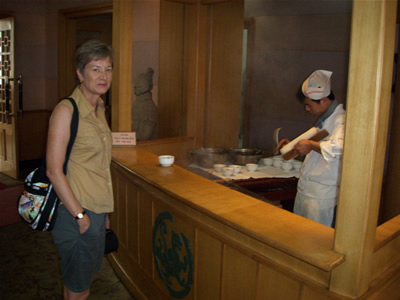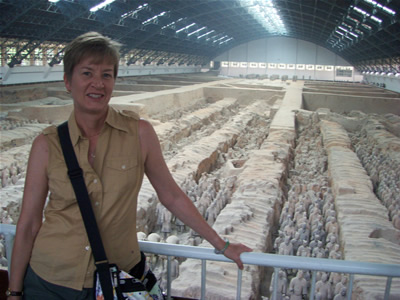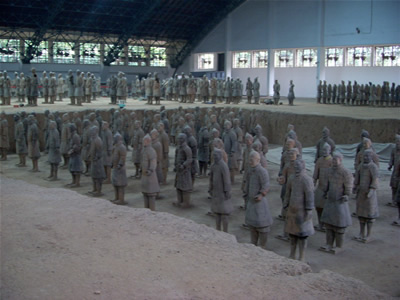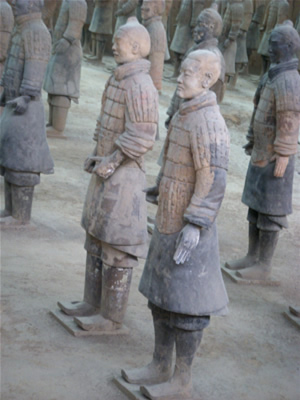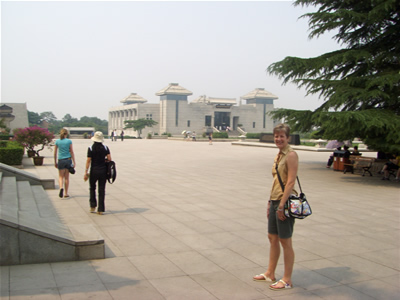China pt 7 - Terracotta Warriors
The Warring States Period was a very chaotic time in Chinese history. As the Zhou dynasty deteriorated in the fifth century BC, the central government lost power and local warlords took control throughout China. At times numbering as many as 40 independent areas, these states were constantly at war. Many famous figures from Chinese history lived during the Warring States Period, such as the famous military strategist Sun Tsu (author of The Art of War), Confucius (philosopher) and Laozi (founder of Taoism).
By late in the third century BC the many regions had consolidated into only seven states each ruled by a king. The strongest of these was Qin and from 230 BC to 221 BC Qin conquered the other six states to unite the modern country of China under the rule of the Qin king. The name "China" comes from the state of Qin (pronounced "chin"). The king of Qin created a new title for himself, Qin Shi Huang which is usually translated into English as "First Emperor".
Qin Shi Huang ruled the new Chinese Empire until his death in 210 BC. After unifying China he moved the capital to Xianlang which is very close to modern Xian. He ordered the construction of a huge mauseleum for himself. Just like the Egyptians and other ancient kings, the Chinese rulers put a huge amount of effort into their tombs which they felt would be their homes for the afterlife. Qin Shi Huang's tomb is buried under a nearby hill and has still not been opened by modern archaeologists. According to accounts from the Han dynasty the First Emperor had a huge map of his empire built in his tomb with rivers and lakes filled with quicksilver. High levels of mercury have been measured in the soils over the tomb which indicate that the ancient account is probably correct.
Like other ancient rulers, the First Emperor filled his tomb with many things that he thought he would need in the afterlife. But one unusual step he took was the construction of the Terracotta Army. Over 8000 life size clay figures of soldiers were constructed and buried near the emperor's tomb. They were to serve as his army to allow him to conquer the realm of the afterlife. Although the location of the First Emperor's tomb was known, the Terracotta Warriors were found by accident in 1974 by local farmers who were digging a well and accidentally broke into the main pit.
There is a huge museum complex at the site. There are large buildings that protect each of the three pits where the Terracotta Army was buried. There is also a large museum displaying items from the excavations as well as buildings with souvenir shops and restaurants. Since we had spent a busy morning already we headed for lunch first. Once again we had noodle dishes and I seemed to be the only one who liked them. This restaurant was fun because you could watch the chefs making the noodles - stretching the dough and slicing the noodles off. They put on a pretty good show.
Then it was on to the main pit. The excavation is huge. It is housed in a building that covers over 3.5 acres. Shortly after being buried, the pit was broken into by rebels who wanted to steal the weapons of the Terracotta Soldiers. There was a fire and the structure supporting the pit collapsed. All of the warriors were damaged and many were almost completely smashed. There was only one figure out of several thousand which was found intact, and this "Lucky One" is on display in the museum on the grounds. The figures were painstakingly reconstructed from the fragments into an entire army of clay warriors. Even more amazing is that every one of the figures is unique. Most scholars believe that they were modeled after the real soldiers in Qin Shi Huang's Imperial Guard. As you look at the lines of clay figures you can easily imagine the real army of soldiers from 2200 years ago upon which they are based. It is unbelievable - an ancient Chinese army from over 2000 years ago standing right in front of you in battle formation.
The figures are arranged in what is believed to be a standard Qin formation. There are three horizontal lines of light troops without armor at the front. Behind them are five columns of heavy infantry. Further back are rows of archers and war chariots. At the very back of pit #1 are a group of warriors that are still being reconstructed. There are also some rows filled with just fragments. It shows just how badly the warriors were damaged and how much work went into putting them back together again. Talk about Humpty Dumpty.
Many of the warriors have still not been excavated. When the original warriors were uncovered they were brightly painted but within hours of being exposed to the air the colors vanished. The remaining warriors will be left buried until the technology for preserving their original colors is available.
After the main pit, we visited the #2 pit and then the #3 where several figures of generals were found. It is believed to represent the headquarters of the Terracotta Army. There were also chariots and horses unearthed at the headquarters to carry the orders of the generals to the army. We also went through the museum where two bronze chariots were on display. These are only one quarter scale because bronze was much more expensive than clay. One chariot is believed to be for the emperor and the other for his chief general. The emperor's chariot was found in over 1200 pieces and has been completely restored. It is truly amazing.
We went to a movie theater where they showed a movie on the First Emperor which was quite good. And we went though the souvenir shop. You could buy large jade figures of the warriors for several thousand dollars. You could even buy a full size clay reproduction of a warrior and have it shipped overseas for a few grand. It would be awesome but I think I will stick with tshirts for souvenirs. My one disappointment is that I really wanted to get a terracotta warriors chess set and I didn't find anything that I liked. But the trip wasn't over yet so I still had a chance on our last day.
The Terracotta Army was absolutely amazing. The First Emperor comes from my favorite period in Chinese history so I was totally fascinated. And for perspective, this lines up with the Second Punic War in the West (any Hannibal fans out there?). While the Terracotta Army was being constructed, he Battle of Cannae was fought in 216 BC on the other side of the world.
